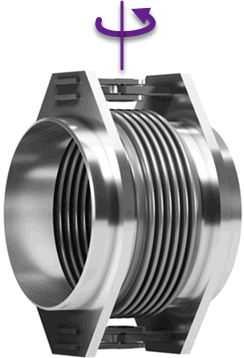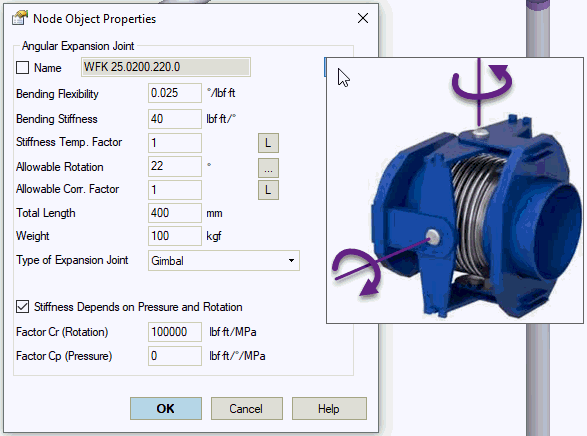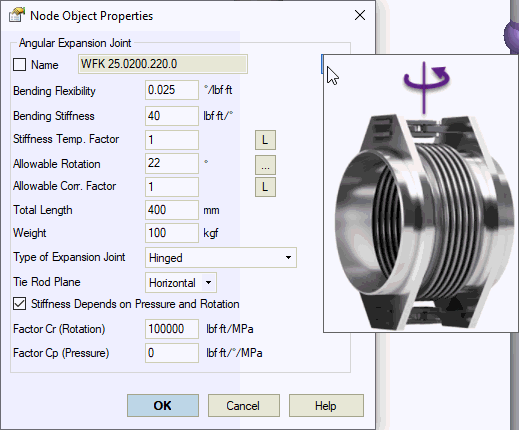

Gimbal expansion joint allows mutual elastic rotation of connected pipe ends around the vertical and horizontal axes. It restricts mutual pipe rotation and all linear displacement. Typical design shown on figure below

Hinged expansion joint allows to rotate around one axis. Typical design shown on figure below

All expansion joint properties can be taken from expansion joints database by pressing the "..." button and selecting the appropriate expansion joint.
Expansion Joint analysis results can be found in Expansion Joint Deformation Table. See also "How to Reduce the Nozzle Loads in START-PROF"


Property |
Description |
Name |
Element name. If checked then it shown in 3D view |
Bending Flexibility |
Bending flexibility, (1/KR) of whole length of expansion joint (all convolutions). Value must be obtained from manufacturer |
Bending Stiffness |
Bending Stiffness, (KR) of whole length of expansion joint (all convolutions). Value must be obtained from manufacturer. In contrast to the finite length flexible element, there's no need to multiply bending stiffness provided by manufacturer by 4, because expansion joint is modeled as zero length. Bending angular stiffness can be calculated by EJMA equation:
Kx = Axial stiffness of the bellows Dm = Effective diameter (mean diameter of the bellows) |
Stiffness Temp. Factor |
For elevated temperatures material elastic modulus is reducing, therefore the stiffness values should be adjusted. This stiffness temperature correction factor is equal to the ratio of elastic modulus at operating and ambient temperature for bellows material and can be specified for each operating mode depending on the temperature
|
Allowable rotation |
Allowable rotation angle - maximum allowable rotational deformation. Value used for expansion joint deformation analysis. Value must be obtained from manufacturer |
Allowable Corr. factor |
Allowable movements are based on a reference number of load cycles and pressure. It should be adjusted to the actual number of cycles and pressure. This allowable correction factor can be specified for each operating mode depending on the pressure
|
Length |
Expansion joint length Lu. In the internal second layer hidden model PASS/START-PROF model this type of expansion joint as zero length expansion joint and adds two rigid elements with length Lu/2 on the both sides. Non zero-length expansion joints can be modeled using Flexible Element |
Weight |
Expansion joint weight that is applied on the rigid elements (half on the left and half on the right) |
Type of expansion joint |
Choose the type: Gimbal or Hinged |
Tie rod plane |
Choose the plane in which the tie rods are located: Vertical, horizontal, custom. For example this is "Vertical"
If custom is selected, then need to specify the angle between the vertical plane and tie rods plane. 0 degree - vertical, 90 degree - horizontal |
Stiffness depends on pressure and rotation |
For angular expansion joint we should also take into account the friction moment in the hinges
P – Internal pressure q – Angular movement KRi – Angular stiffness on i iteration Ca - Bending stiffness (KR) Algorithm is following: Set bellows angular stiffness KR0=Ca+P*Cp, and perform analysis. Get the rotation angle q Set bellows angular stiffness KR1=Ca+P*Cp+(Cr*P)/q, and perform analysis. Get the new rotation angle q Repeat step 2 PASS/START-PROF performs this iteration process automatically. Usually 3 steps (iterations) are enough to achieve convergence. |
Factor Cr (rotation) and Cp (pressure) |
Cr and Cp factors should be provided by expansion joint manufacturer. For example, WITZENMANN provides the following values:
|
Insert > Expansion Joint > Angular